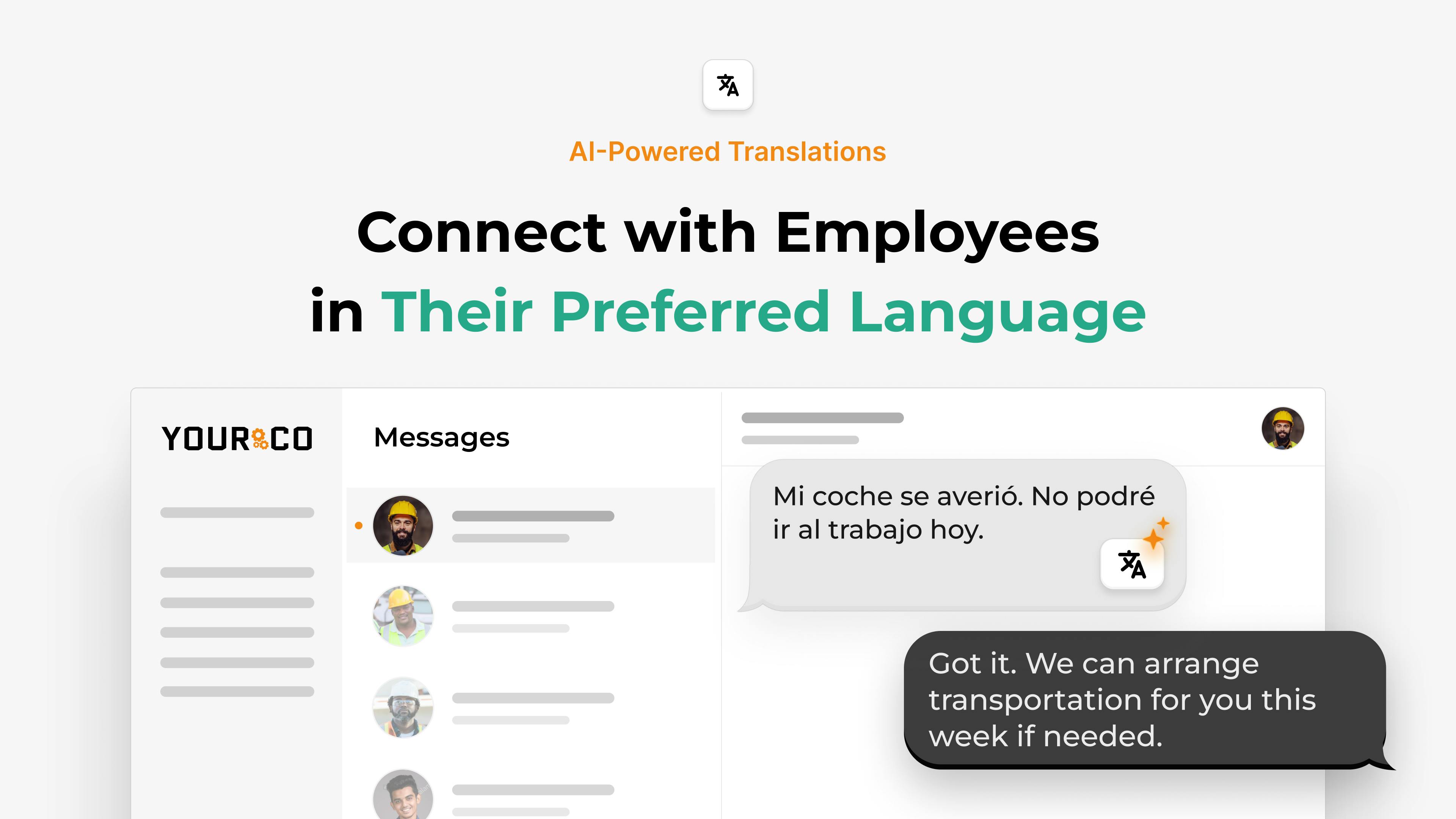Complete Checklist to Onboard Vietnamese-Speaking Workers Successfully


Vietnamese is the sixth-most spoken language in the United States, with more than 1.5 million speakers across warehouses, manufacturing plants, and service industries. From 1980 to 2010, Vietnamese became the fastest-growing language in America, yet many onboarding programs still default to English-only training materials and safety protocols. When new hires can't fully understand their first-day instructions or workplace policies, you risk compliance failures, safety incidents, and costly early turnover that undermines productivity.
The challenge runs deeper than simple translation. About 64% of Vietnamese workers report speaking English less than "very well," compared to 46% of all immigrants. When critical safety information, benefits enrollment, or emergency procedures get lost in translation, both employees and employers face unnecessary risks. A single miscommunication about equipment protocols can lead to injuries or regulatory violations.
Building an inclusive onboarding process changes everything. Translated documents, bilingual mentors, and culturally aware communication help Vietnamese-speaking employees understand their roles, work safely, and feel valued from day one. This comprehensive checklist walks you through every stage of integration—from pre-arrival preparation through 90-day feedback—so you can create an onboarding experience that genuinely supports your Vietnamese-speaking workforce.
Before Day One: Set the Foundation
Preparation before arrival prevents misunderstandings and demonstrates your commitment to inclusive communication from the very beginning.
Prepare Translated Documents and Resources
Get essential materials ready in Vietnamese before new hires arrive. Offer letters, safety procedures, I-9 instructions, and benefits guides should be clear and accessible in their preferred language. This prevents last-minute scrambling to translate critical information and reduces confusion during those crucial first days.
Focus on professional translation for legal documents and safety materials, while leveraging automated translation tools for routine communications and updates. Vietnamese has specific formal and informal registers, so working with native speakers or professional translators ensures your materials convey the right tone and meaning for workplace contexts.
Essential documents to prepare:
- Vietnamese versions of employment contracts and offer letters
- Translated safety manuals and equipment operating procedures
- Benefits enrollment guides and healthcare information in Vietnamese
- Bilingual I-9 forms and tax withholding instructions
- Digital access to company policies with language switching capabilities
Assess Language Preferences Early
Determine communication preferences before the first day through a simple text-based survey about spoken and written Vietnamese comfort levels. Some employees prefer formal Vietnamese for official documents but feel comfortable with English for daily conversations. Others may want all communications in Vietnamese initially.
With Yourco's platform, you can set language preferences once and automatically deliver every text message, reminder, or survey in Vietnamese without manual translation work. This early assessment also helps you adjust training pace and identify employees who might benefit from additional language support.
Assign a Vietnamese-Speaking Mentor
Pair every Vietnamese-speaking new hire with a trusted bilingual colleague who shares cultural background and workplace experience. A quick text exchange or phone call before the first shift lets questions surface naturally and helps new employees feel connected immediately.
Choose mentors who understand both Vietnamese cultural communication styles and your company's daily operations. Give them clear expectations like weekly check-ins via SMS, immediate support for urgent questions, and knowing when to escalate issues to HR or management.
First Day: Create Immediate Comfort
Starting with Vietnamese-language support demonstrates respect for your new employee's background and removes communication barriers right away.
Deliver Welcome Messages and Orientation in Vietnamese
Begin the morning with a warm greeting in Vietnamese: "Chào mừng bạn, chúng tôi rất vui mừng có bạn ở đây!" provides an immediate signal that you've planned specifically for their success. Give them a printed or digital agenda in Vietnamese so they know exactly where to go and when throughout their first day.
Safety training takes priority during first-day orientation. Deliver hazard briefings, emergency procedures, and facility rules in Vietnamese, then reinforce with visual demonstrations that support comprehension. This approach reduces accident risk and establishes a strong safety culture from hour one.
First-day priorities:
- Send Vietnamese welcome message and daily schedule via text
- Conduct bilingual facility tour emphasizing safety zones and emergency exits
- Share translated emergency contact information as secure links
- Deliver Vietnamese-language safety demonstration with hands-on practice
- Introduce new hire to immediate supervisor and team in Vietnamese
Conduct Facility Tours and Systems Training
Walk new hires through essential areas: time clocks, break rooms, safety equipment locations, and any software they'll use daily. When digital systems only offer English interfaces, create visual guides with Vietnamese labels or short instructional videos.
Visual aids make a significant difference, especially in noisy manufacturing or warehouse environments. Even experienced workers can miss critical details when mentally translating everything. Digital platforms allow you to preload Vietnamese FAQs and reference materials that new hires can access later from their phones.
Connect with Mentor and Manager
Arrange relaxed introductions that go beyond formal presentations. Grab coffee together, walk to their workstation, or discuss shared interests rather than conducting conference room meetings. Give the Vietnamese-speaking mentor extra time on day one to answer questions privately and establish trust.
When managers join conversations, encourage genuine dialogue. Instead of just asking "Bạn có hiểu không?" ask them to explain key points back in Vietnamese. This confirms understanding without creating pressure or embarrassment.
First Week: Build Confidence and Clarity
The first week transforms initial impressions into lasting confidence through consistent Vietnamese-language support and clear communication channels.
Conduct Comprehensive Bilingual Training
When safety briefings, HR policies, and benefits explanations appear in Vietnamese, employees absorb crucial details instead of nodding along confused. Skip dense presentations for photos, diagrams, and live demonstrations—visual learning works across language barriers and creates lasting retention.
Role-specific training follows the same approach. Whether training a forklift operator on load capacity or teaching proper chemical handling procedures, provide Vietnamese materials and walk through each step with hands-on practice.
Establish Clear Expectations and Milestones
Translate the 30/60/90-day roadmap so new hires see progress milestones, mentor check-ins, and evaluation dates in their own language. Keep the layout simple with icons, bullet points, and progress indicators rather than dense paragraphs.
Cultural considerations matter in Vietnamese workplace communication. Some employees may hesitate to self-promote or highlight achievements, so encourage them to document wins and ask questions during milestone conversations without fear of appearing presumptuous.
Maintain Daily Check-ins
Text-based communication in Vietnamese lets you ask "Hôm nay mọi thứ có ổn không?" and receive immediate replies from any phone, including basic models without internet access. Send brief check-in messages every afternoon during week one, then transition to twice-weekly as confidence builds.
Modern platforms like Yourco automatically translate your English messages into Vietnamese, eliminating the need to manually craft bilingual communications while maintaining personal connection. This employee texting approach proves especially effective for non-desk workers who may not have regular computer access.
Effective starter questions include:
- "Bạn có hiểu rõ các quy trình an toàn không?"
Do you understand the safety procedures clearly? - "Bạn có cần hỗ trợ với phần đào tạo hôm nay không?"
Do you need help with today's training? - "Bạn cảm thấy thế nào về đội nhóm mới?"
How do you feel about your new team?
Pay attention to tone and context in responses. Vietnamese communication often includes indirect feedback, so phrases like "có lẽ hơi khó hiểu" (perhaps a bit difficult to understand) may signal more significant confusion. Follow up with a phone call or in-person conversation, ideally with the bilingual mentor who can explore concerns more deeply.
First 30-90 Days: Reinforce and Recognize
The first three months determine long-term success, so focus on skills reinforcement, honest feedback collection, and celebrating achievements in your employee's preferred language.
Reinforce Training Through Multiple Channels
Skills development needs ongoing practice beyond initial orientation, so consider texting employees secure links to Vietnamese refresher videos and quick reference materials. This approach lets them review procedures anytime from their phones while building confidence through repetition.
Many companies send automated safety reminders in Vietnamese. Simple messages like "Nhớ đeo kính bảo hộ" (Remember your safety glasses) arrive before shifts and help reduce workplace accidents.
New hires can text photos of completed training checklists or safety documentation directly to your company number, creating instant records without requiring email or special applications.
Gather Regular Feedback
Send brief text-based surveys in Vietnamese at Day 30 and Day 90. Ask if training materials were clear, which tasks still feel challenging, and how supported they feel by teammates. Text surveys consistently achieve higher response rates than email, helping you capture better feedback and identify issues before they become safety concerns or cause turnover.
Vietnamese employees can respond with simple number ratings (1-5 scale) or short text answers, making participation easy even for those without smartphones or strong data plans.
Keep in mind that Vietnamese culture values respect and harmony, so workers may hesitate to say “no” or share negative feedback directly. HR and managers should emphasize that feedback is essential for the company’s growth and that all constructive input is welcome and valued.
Celebrate Progress and Achievements
Quick recognition, whether spoken in Vietnamese during daily communications or sent as a thank-you text after excellent work, shows respect for their effort and cultural background. Recognition styles vary across cultures: many Vietnamese employees value team-centered praise over individual spotlights, so take cues from your mentor system when deciding how to highlight achievements.
Small gestures, like adding Vietnamese congratulations to break-room announcements or sending "Chúc mừng!" messages for completed certifications, demonstrate that bilingual communication extends beyond paperwork into everyday workplace culture.
After 90 Days: Transition to Growth
After three months, shift focus from orientation to long-term development while maintaining the language support that created initial success.
Create Development Pathways
Your Vietnamese-speaking team member should feel settled after 90 days. Create a simple, bilingual career roadmap showing skills, certifications, and wage progression tied to each advancement level. Provide printed or digital copies in Vietnamese, then schedule one-on-one conversations to discuss opportunities.
If the role benefits from stronger English skills, offer optional language learning resources through established platforms. Frame this as an additional benefit, not a requirement. This approach respects current strengths while opening doors for future advancement.
Continue Cultural Support
Maintain regular check-ins with the original Vietnamese-speaking mentor. This helps employees navigate unwritten workplace rules and cultural norms that don't appear in training manuals. Strong mentoring relationships that value language and cultural identity drive long-term engagement. Consider implementing structured feedback systems that make it easy for Vietnamese-speaking employees to share concerns or suggestions.
Encourage employees to text questions or concerns directly to their supervisor's company number. They can send photos of equipment issues or safety concerns for immediate documentation and response, creating a direct communication channel that builds trust.
Request Process Improvement Feedback
Strong programs continuously improve. Send a comprehensive Day-90 survey in Vietnamese covering training effectiveness, sense of belonging, role confidence, and suggestions for future improvements. Design questions that remain open-ended and culturally aware.
Look beyond satisfaction scores when analyzing responses. Track patterns like repeated safety questions, slow benefits enrollment, or communication gaps. Connect survey insights with retention data, attendance records, and incident reports to identify trends and refine future processes.
Close the feedback loop by sharing key findings and action steps with both the employee and their manager. Demonstrating that input leads to meaningful change proves that Vietnamese voices matter and establishes expectations for ongoing dialogue.
Build Inclusive Teams with Smart Communication
Language-inclusive onboarding transforms how Vietnamese-speaking employees experience their first months at your company. When you provide translated materials, assign bilingual mentors, and maintain clear communication throughout the integration process, you create an environment where everyone can contribute from day one.
Success comes from meeting people where they are. Instead of expecting employees to navigate complex safety procedures or benefits enrollment in their second language, you remove barriers and demonstrate respect for the experience and skills they bring to your organization. For additional insights, explore our guide on how to onboard Vietnamese-speaking employees effectively.
Yourco makes this approach scalable across multiple locations and hiring cycles. New hires can text photos of their documentation without needing email access. You can send welcome messages, training materials, and milestone follow-ups in Vietnamese, while they can ask questions about procedures at their convenience via text.
With AI-powered translation supporting over 135 languages and instant delivery that works on any phone, you can maintain personal connections while scaling efficiently across your entire workforce.
Ready to transform your onboarding process? Try Yourco for free today or schedule a demo to create a more effective, inclusive workplace experience.
Frequently Asked Questions
What's the best way to determine a Vietnamese employee's communication preference?
Ask during the application or interview process through a simple questionnaire about spoken and written Vietnamese comfort levels. Modern communication platforms can store these preferences, so every text message, survey, and reminder automatically goes out in Vietnamese without additional work for HR teams.
Are machine translation tools adequate for Vietnamese onboarding materials?
For daily messages and routine updates, automated tools work effectively. However, employment contracts, safety manuals, and policy documents require professional Vietnamese translators to avoid costly miscommunications. Expert translation protects you from compliance issues and ensures workplace safety information is accurately conveyed.
How can I verify that Vietnamese-speaking employees understand safety procedures?
Combine clear Vietnamese instructions with hands-on demonstrations and visual aids. Follow up during the first week and again at 30 days with practical assessments. Text reminders work well. Send quick Vietnamese safety tips and ask employees to confirm receipt with a simple "OK" reply. This supports safety compliance while creating documentation.
How do I maintain engagement beyond the first week?
Continue sending shift updates, company news, and feedback surveys in Vietnamese. Two-way texting keeps communication open even when employees work off-site or across different shifts. Platforms with automatic language detection make it simple to check in regularly and demonstrate ongoing support after orientation concludes.




